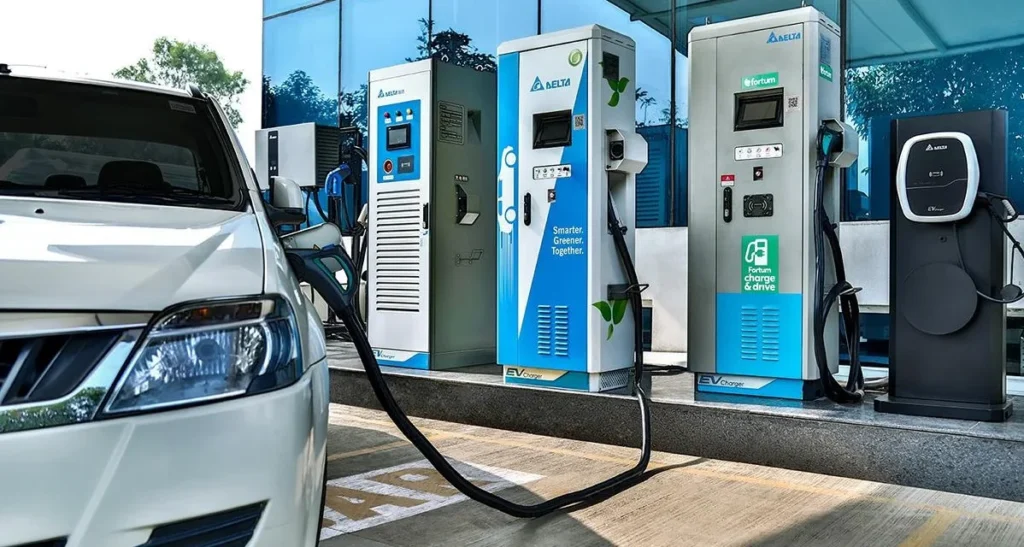EV Chargers in India: Explore India’s burgeoning EV charging landscape. From Tata Power’s vast network to government incentives like FAME II and the EV Mitra Scheme, this article delves into charger types, connector standards, key players, and the future of electric mobility in India.
ev charger india, charging stations india, electric vehicle charging, EV infrastructure, FAME II, EV Mitra Scheme
India’s electric vehicle (EV) sector is experiencing swift expansion, with one of the pivotal elements driving this shift being the establishment of a comprehensive and reliable charging infrastructure.

An overview of the prominent features related to EV chargers across India includes:
Categories of EV Chargers
AC (Alternating Current) Chargers:
- Level 1 (Slow Charging): Primarily designed for home use, these chargers connect to standard wall outlets and require a longer duration—typically 8 to 12 hours—for a full EV battery charge, as noted by Bacancy Systems. Their power output ranges between 3 and 6 kW.
- Level 2 (Fast Charging): Commonly installed in public venues such as shopping malls and office complexes, Level 2 chargers deliver significantly quicker charging, roughly up to eight times faster than Level 1. They operate on a 240V supply with power outputs spanning from 7 to 22 kW.
DC (Direct Current) Chargers (Level 3 – Rapid Charging):
- Representing the fastest charging option available, these chargers convert AC power to DC onsite to enable rapid battery replenishment. They can boost an EV’s charge to about 80% within just 30 minutes. Typically located at public charging hubs and corporate campuses, rapid chargers operate at 50 kW, while ultra-rapid variants support power outputs exceeding 100 kW.
Common Connector Standards
- Type 2: The standard connector for AC charging in India, frequently seen in residences, workplaces, and commercial locations.
- CCS (Combined Charging System): A widely adopted protocol for DC fast charging in contemporary EVs, capable of delivering power up to 350 kW.
- CHAdeMO: An early fast-charging technology, though increasingly being phased out in favor of CCS with newer vehicle models.
- GB/T: Previously endorsed by the Indian government under the Bharat DC 001 norm, these connectors provide lower power output between 10 and 15 kW.
Leading EV Charger Manufacturers in India
Several prominent companies are shaping India’s EV charging ecosystem:
- Tata Power: Operating the country’s largest EV charging network, boasting over 5,500 charging stations spread across more than 550 cities.
- E-Fill Electric: Headquartered in Sonipat, Haryana, renowned for advanced chargers ranging from 3.3 kW up to 240 kW.
- Delta Electronics India: Offering an extensive portfolio, including AC, DC, and ultra-fast charging solutions.
- ABB India: Providing a variety of chargers encompassing fast and ultra-fast options.
- Exicom: Delivering AC and DC charging products with capacities from 1.5 kW to 350 kW.
- Magenta Power: Known for innovative, sustainable charging infrastructure marketed under the “Charge Grid” brand.
- Ather Energy: Beyond electric scooters, they manage the “Ather Grid” network comprising fast-charging stations.
- EV Motors India: Key player offering DC rapid chargers under the “PlugNgo” brand.
- Fortum India: Concentrates on DC fast chargers, expanding their presence along key highways and urban centers.
- Okaya Power: Provides both AC and DC charging units.
- Servotech Power Systems: Supplies comprehensive charging solutions including both hardware and software components.
Government Policies and Incentives
The Indian government is proactive in accelerating EV adoption and infrastructure build-out through several programs:
- FAME I and II (Faster Adoption and Manufacturing of Electric Vehicles): These initiatives incentivize EV purchases and support the development of charging stations.
- EV Mitra Scheme 2025: Designed to simplify the process and provide subsidies for individuals and enterprises establishing EV charging points.
- PM E-DRIVE Scheme: Extended until March 31, 2028, this scheme offers demand-side incentives for EV acquisition and promotes public charging infrastructure alongside local EV technology development.
- Production Linked Incentive (PLI) Schemes: Focused on boosting the manufacturing of Advanced Chemistry Cell (ACC) batteries and components within the automotive sector.
- Electricity Tariff Subsidies: EV charging stations benefit from capped electricity tariffs, calculated as Average Cost of Supply plus 15%, which is more economical than standard commercial rates.
- Reduced GST: A favorable 5% Goods and Services Tax applies to EVs and associated charging equipment.
- State-Level Benefits: Numerous states provide additional incentives including capital subsidies, interest rate reductions, and tax breaks.
Establishing an EV Charging Station
Fundamental Requirements: Selecting an accessible site—either owned or leased—with adequate electrical capacity and easy public access is essential.
Investment Estimates: Setting up basic charging facilities may cost a few lakhs, while fully equipped stations featuring fast chargers typically require investments ranging from ₹50 lakh to ₹1 crore.
Profitability Outlook: Financial viability hinges on usage rates and scale of investment, with many operators achieving steady returns within one to two years.
Future Prospects
India’s EV charging market is undergoing rapid transformation, fueled by active participation from private companies and government initiatives. Emphasis on integrating renewable energy sources, incorporating smart technologies, and enhancing user-friendly designs is steering the sector’s evolution. Collaborative efforts among energy providers, automobile manufacturers, and technology startups are critical in expanding and refining the nation’s public EV charging infrastructure.
By fostering such innovation and infrastructure development, India is positioning itself to meet the growing demand for electric mobility with a robust and sustainable charging ecosystem.